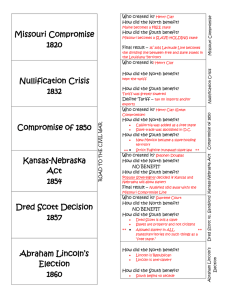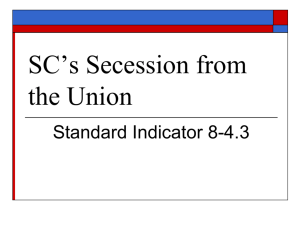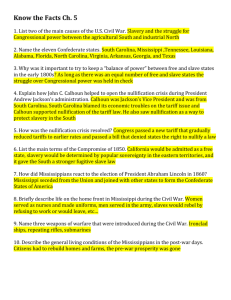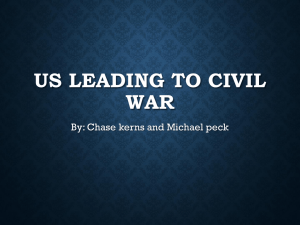Missouri enters as a slave state Lincoln is elected president
advertisement
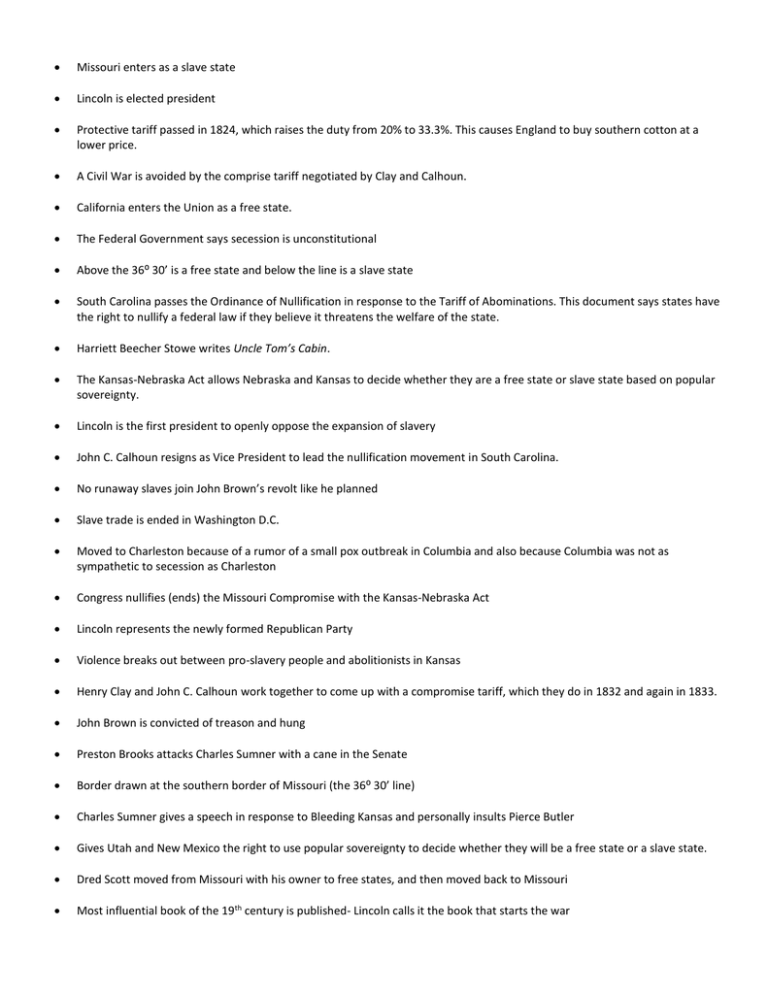
Missouri enters as a slave state Lincoln is elected president Protective tariff passed in 1824, which raises the duty from 20% to 33.3%. This causes England to buy southern cotton at a lower price. A Civil War is avoided by the comprise tariff negotiated by Clay and Calhoun. California enters the Union as a free state. The Federal Government says secession is unconstitutional Above the 36⁰ 30’ is a free state and below the line is a slave state South Carolina passes the Ordinance of Nullification in response to the Tariff of Abominations. This document says states have the right to nullify a federal law if they believe it threatens the welfare of the state. Harriett Beecher Stowe writes Uncle Tom’s Cabin. The Kansas-Nebraska Act allows Nebraska and Kansas to decide whether they are a free state or slave state based on popular sovereignty. Lincoln is the first president to openly oppose the expansion of slavery John C. Calhoun resigns as Vice President to lead the nullification movement in South Carolina. No runaway slaves join John Brown’s revolt like he planned Slave trade is ended in Washington D.C. Moved to Charleston because of a rumor of a small pox outbreak in Columbia and also because Columbia was not as sympathetic to secession as Charleston Congress nullifies (ends) the Missouri Compromise with the Kansas-Nebraska Act Lincoln represents the newly formed Republican Party Violence breaks out between pro-slavery people and abolitionists in Kansas Henry Clay and John C. Calhoun work together to come up with a compromise tariff, which they do in 1832 and again in 1833. John Brown is convicted of treason and hung Preston Brooks attacks Charles Sumner with a cane in the Senate Border drawn at the southern border of Missouri (the 36⁰ 30’ line) Charles Sumner gives a speech in response to Bleeding Kansas and personally insults Pierce Butler Gives Utah and New Mexico the right to use popular sovereignty to decide whether they will be a free state or a slave state. Dred Scott moved from Missouri with his owner to free states, and then moved back to Missouri Most influential book of the 19th century is published- Lincoln calls it the book that starts the war People from the North and South move into Kansas to vote Expands slavery into other states by declaring the Missouri Compromise and the Compromise of 1850 unconstitutional. John Brown leads a group of supporters to Harpers Ferry, Virginia Four candidates are Lincoln, Breckenridge, Douglas, and Bell Maine enters the union as a free state The North convinces Congress to raise the tariff from 33.3% to 50% in 1828, this becomes known as the “Tariff of Abominations” Militias begin to form throughout the South, which eventually becomes the Confederate Army Brooks is thrown out of Congress but is regarded as a hero in the South and receives multiple canes. A slave named Dred Scott goes to the Supreme Court to fight for his freedom. The election is very split between the North and the South- the South votes for Breckenridge, while the North votes for Lincoln John Brown captures the arsenal at Harpers Ferry, but is then overtaken by the VA militia The Fugitive Slave Law is passed, which forces people in the north to help the south catch runaway slaves. 10 states in the South do not even allow Lincoln’s name on the ballot Meeting reconvened Dec. 20th, adopted the Ordinance of Secession Dred Scott believed he should be free since he lived in free states John Brown cuts up five pro-slavery people in Kansas The Supreme Court decides that slaves are not citizens and cannot sue in court and that the federal government cannot legislate whether or not a state is free. Andrew Jackson asks Congress to pass the Force Bill, which gives him the right to use military force to enforce the tariffs in South Carolina. Maintains the balance between the slave states and free states in the Louisiana Purchase territories The abolition movement increases in the North as a result of Harriet Beecher Stowe’s book. Leads to the Secession Convention of 1860 in South Carolina
